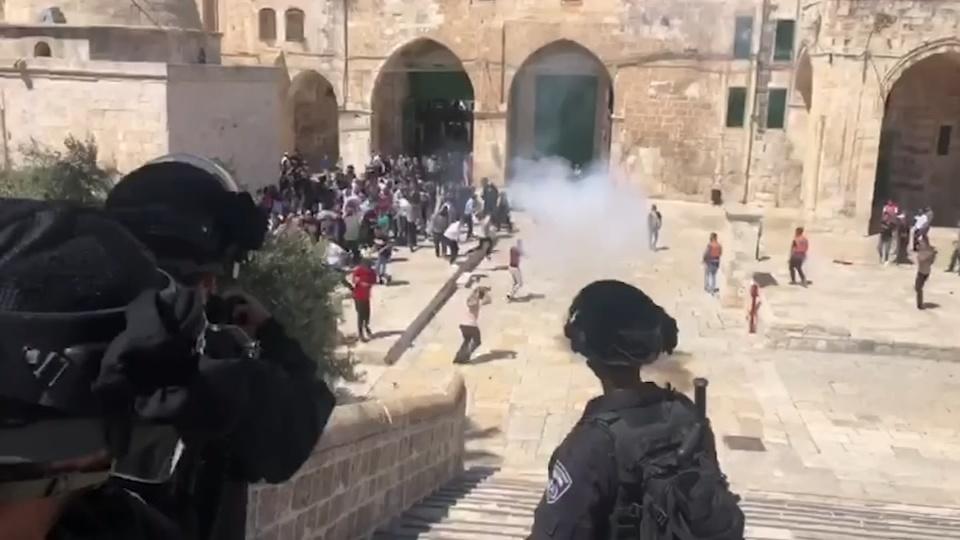Palestinians Mark 47th Land Day Amid Calls To End Israeli Occupation
Apr 1, 2023 | Pratirodh Bureau
A view of clashes between Israeli forces and Palestinian protestors outside Jerusalem's Al-Aqsa Mosque (Representative Image)
Source: IANS
Palestinians marked the 47th anniversary of the “Land Day” amid calls to end the Israeli occupation of the Palestinian territories that has been going on since 1967. They also called for establishing an independent Palestinian state on the territories seized by Israel in 1967, with East Jerusalem as its capital, reports Xinhua news agency.
Hundreds of demonstrators gathered near the borders between the eastern Gaza Strip and Israel, waving Palestinian flags, carrying banners demanding an end of the Israeli occupation and establishing an independent Palestinian state, and chanting anti-Israel slogans.
Demonstrations and rallies were also held in other parts of the Gaza Strip to mark the day. Some young people planted olive trees, with each one carrying the name of a village in historic Palestine that their grandfathers left in 1948.
In the West Bank, similar demonstrations are scheduled in several towns, villages and cities on Friday. Palestinian Prime Minister Mohammed Ishtaye slammed the Israeli actions as aggressive and said the Israeli occupation “is based on settlement, repression, and killing”.
Ishtaye called on the Palestinians to reunite and end an internal division, mainly between Hamas and President Mahmoud Abbas Fatah Party since 2007.
The events of Land Day date back to March 30, 1976, when the Palestinians in Israel protested against the Israeli seizure of about 21,000 dunams (2,100 hectares) of village lands in the Galilee region. The 1976 protests took place in the villages of Arraba, Sakhnin, Deir Hanna, Arab al-Sawa’id and others. The lands in these villages were confiscated for establishing more settlements.
During the Land Day events, a new sense of national pride, together with anger toward the state and police and sorrow over the dead protesters, developed among the Arab community in Israel.
A split erupted between the Arab political parties of Rakah and Abnaa al-Balad. Committed to a two-state solution to the Israeli–Palestinian conflict, Rakah held major reservations about the involvement of Palestinians from the West Bank. Conversely, Abnaa al-Balad’s commitment to the establishment a single democratic Palestine saw the issues of land, equality, the refugees and the occupation as “a comprehensive, integral and indivisible whole.”
While Rakah remained committed to a two-state solution, it charted a delicate balance, expressing a Palestinian identity more clearly so as to be more in tune with community sentiment. For example, shortly after Land Day, Tawfiq Ziad (a Palestinian-Israeli politician well known for his “poetry of protest”) declared that, “From now on there will be no communities and religious groups but only a single Arab minority, part of the Palestinian nation.”
Land Day also resulted in the Arabs gaining a presence in Israeli politics in that they could no longer be ignored. Arab civil society in Israel began coordinating with one another more and protests against government policies became more frequent with a focus on three major issues: land and planning policies, socio-economic conditions, and Palestinian national rights.
The protest did little to stop the 1975 land expropriation plan. The number of mitzpim established reached 26 in 1981 and 52 in 1988. These mitzpim and the “development towns” of Upper Nazareth, Ma’alot, Migdal Ha’emeq and Carmiel significantly altered the demographic composition of the Galilee. While Arabs had comprised 92% of the population of the Galilee in the years following Israel’s establishment, by 1994, that number was reduced to 72% out of a regional population of 680,000, with Jews making up the remaining 28%. Large-scale expropriations of land in the Galilee have generally been avoided by Israeli governments since the 1980s.
